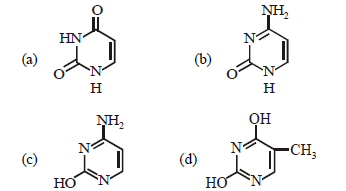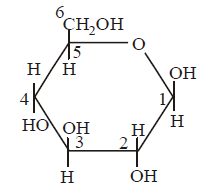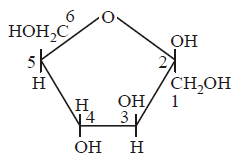VBQs Biomolecules Class 12 Chemistry with Biomolecules has been provided below for standard students. We have provided chapter wise VBQ for Class 12 Chemistry with Biomolecules. The following Biomolecules Class 12 Chemistry value based questions with answers will come in your exams. Students should understand the concepts and learn the solved cased based VBQs provided below. This will help you to get better marks in class 12 examinations.
Biomolecules VBQs Class 12 Chemistry
Question. The latest discovery in cytology is that of
(a) respiration
(b) genetic code
(c) enzyme
(d) None of these
Answer
B
Question. Which one of the following, statements is incorrect about enzyme catalysis?
(a) Enzymes are mostly proteinous in nature.
(b) Enzyme action is specific.
(c) Enzymes are denaturated by ultraviolet rays and at high temperature.
(d) Enzymes are least reactive at optimum temperature.
Answer
D
Question. Which of the following statements regarding DNA fingerprinting is incorrect?
(a) It is used in forensic laboratories for identification of criminals.
(b) It cannot be altered by surgery.
(c) It is different for every cell and cannot be altered by any known treatment.
(d) It is used to determine paternity of an individual.
Answer
C
Question. α- Helix is found in
(a) DNA
(b) RNA
(c) lipid
(d) carbohydrates
Answer
A
Question. Which is a fat soluble vitamin?
(a) Vitamin A
(b) Vitamin B6
(c) Vitamin C
(d) Vitamin B2
Answer
A
Question. The segment of DNA which acts as the instrumental manual for the synthesis of the protein is:
(a) ribose
(b) gene
(c) nucleoside
(d) nucleotide
Answer
B
Question. Enzymes are essential as biocatalysts. They function in
(a) aqueous medium, temp = 30–35ºC; pH=7
(b) organic medium
(c) aqueous medium under extreme pH conditions
(d) None of these
Answer
A
Question. Anaemia is caused by the deficiency of vitamin
(a) B6
(b) B1
(c) B2
(d) B12
Answer
D
Question. Among the following vitamins the one whose deficiency causes rickets (bone deficiency) is :
(a) Vitamin A
(b) Vitamin B
(c) Vitamin D
(d) Vitamin C
Answer
C
Question. Vitamin B2, a water soluble vitamin is also known as
(a) ascorbic acid
(b) riboflavin
(c) thiamine
(d) pyridoxine
Answer
B
Question. Which of the following statements about vitamin B12 is incorrect ?
(a) It has a cobalt atom
(b) It also occurs in plants
(c) It is also present in rain water
(d) It is needed for nhuman body in very small amounts
Answer
C
Question.The function of DNA in an organism is
(a) to assist in the synthesis of RNA molecule
(b) to store information of heredity characteristics
(c) to assist in the synthesis of proteins and polypeptides
(d) All of these
Answer
D
Question. Which of the following is correct about H-bonding in nucleotide?
(a) A — A and T — T
(b) G — T and A — C
(c) A — G and T — C
(d) A — T and G — C
Answer
D
Question. Which of the following structures represents thymine ?

Answer
D
Question. In DNA, the complimentary bases are:
(a) Adenine and thymine; guanine and cytosine
(b) Adenine and thymine ; guanine and uracil
(c) Adenine and guanine; thymine and cytosine
(d) Uracil and adenine; cytosine and guanine
Answer
A
Question. Energy is stored in our body in the form of
(a) ATP
(b) ADP
(c) fats
(d) carbohydrates
Answer
A
Question. In DNA the linkages between different nitrogenous bases are :
(a) peptide linkage
(b) phosphate linkage
(c) H-bonding
(d) glycosidic linkage
Answer
B
Question. When adenine is attached to ribose sugar, it is called adenosine. To make a nucleotide from it, it would require
(a) oxygenation
(b) addition of a base
(c) addition of phosphate
(d) hydrogenation
Answer
C
Question. Chromosomes are made from
(a) proteins
(b) nucleic acids
(c) proteins and nucleic acids
(d) carbohydrates and nucleic acids
Answer
C
Question. Which of the following statements is incorrect?
(a) Enzymes are organic catalysts
(b) Enzymes have a very large turnover number
(c) Enzymes action is specific
(d) Enzymes always require a coenzyme in their catalytic action.
Answer
D
Question. Vegetable oils like wheat gram oil, sunflower oil etc. are the good source of
(a) vitamin K
(b) vitamin E
(c) vitamin D
(d) vitamin A
Answer
B
Question. The double helical structure of DNA was proposed by
(a) Watson and Crick
(b) Meichers
(c) Emil Fischer
(d) Khorana
Answer
A
Question. The couplings between base units of DNA is through :
(a) Hydrogen bonding
(b) Electrostatic bonding
(c) Covalent bonding
(d) van der Waals forces
Answer
A
Question. Which of the following compounds is responsible for the transmission of heredity characters?
(a) RNA
(b) DNA
(c) Glucose
(d) Haemoglobin
Answer
B
Question. Deficiency of vitamin B1 causes the disease
(a) Convulsions
(b) Beri-Beri
(c) Cheilosis
(d) Sterility
Answer
B
Question. The chemical change in DNA molecule that could lead to synthesis of protein with an altered amino acid sequence is called
(a) replication
(b) lipid formation
(c) cellular membrane
(d) mutation
Answer
D
Question. Enzymes are made up of
(a) Edible proteins
(b) Proteins with specific structure
(c) Nitrogen containing carbohydrates
(d) Carbohydrates
Answer
B
Question. The vitamin that is not soluble in water is
(a) Vitamin B1
(b) Vitamin B2
(c) Vitamin B6
(d) Vitamin D
Answer
D
Question. The process by which synthesis of protein takes place based on the genetic information present in m-RNA is called
(a) Translation
(b) Transcription
(c) Replication
(d) Messenger hypothesis
Answer
A
Question. DNA multiplication is called as
(a) translation
(b) transduction
(c) transcription
(d) replication
Answer
D
Question. Which of the following is not present in a nucleotide?
(a) Guanine
(b) Cytosine
(c) Adenine
(d) Tyrosine
Answer
D
Question. Insulin production and its action in human body are responsible for the level of diabetes. This compound belongs to which of the following categories?
(a) An enzyme
(b) A hormone
(c) A co-enzyme
(d) An antibiotic
Answer
B
Question. The enzyme which hydrolyses triglycerides to fatty acids and glycerol is called
(a) Maltase
(b) Lipase
(c) Zymase
(d) Pepsin
Answer
B
Question. DNA has deoxyribose, a base and the third component which is
(a) phosphoric acid
(b) ribose
(c) adenine
(d) thymine
Answer
A
STATEMENT TYPE QUESTIONS
Question. Which of the following statement(s) is/are correct?
(i) Glucose is reducing sugar
(ii) Sucrose is reducing sugar
(iii) Maltose is non reducing sugar
(iv) Lactose is reducing sugar
(a) (i) and (ii) only
(b) (i) and (iii) only
(c) (i) and (iv) only
(d) All of these
Answer
C
Question. Which of the statements about “Denaturation” given below are correct ?
(i) Denaturation of proteins causes loss of secondary and tertiary structures of the protein.
(ii) Denaturation leads to the conversion of double strand of DNA into single strand
(iii) Denaturation affects primary strucrture which gets distorted
(a) (ii) and
(b) (i) and (iii)
(c) (i) and (ii)
(d) (i), (ii) and (iii) (iii)
Answer
C
Question. Which of the following statements regarding carbohydrates are correct?
(i) Lactose is the carbohydrate found in milk.
(ii) More than 25 monosaccharides occur naturally.
(iii) Sucrose on hydrolysis gives one molecule each of glucose and fructose.
(iv) Maltose is a non-reducing sugar whereas sucrose is a reducing disaccharide sugar.
(a) (i), (ii) and (iii)
(b) (i) and (iii)
(c) (ii), (iii) and (iv)
(d) (iii) and (iv)
Answer
B
Question. Which of the following statements are correct ?
(i) Vitamins A, D, E and K are insoluble in water.
(ii) Vitamins A, D, E and K are stored in liver and adipose tissues.
(iii) Vitamin B and vitamin C are water soluble.
(iv) Water soluble vitamins should not be supplied regularly in diet.
(a) (i), (ii) and (iv)
(b) (i), (ii) and (iii)
(c) (i) and (iv)
(d) (ii) and (iv)
Answer
B
Question. Consider the following statements.
(i) Linkage between two monosaccharide units through oxygen atom is called glycosidic linkage.
(ii) Sucrose on hydrolysis gives an equimolar mixture of fructose and glucose which is dextrorotatory.
(iii) Lactose consists of linkage between C1 of galactose and C4 of glucose.
(iv) Out of two components of starch the component present in greater proportion is insoluble in water.
(v) Glycogen is also known as animal starch because it is structurally similar to amylose a component of starch.
Which of the following is the correct code for statements above?
(a) FFFTT
(b) FTTTF
(c) TFTFT
(d) TFTTF
Answer
D
Question. Read the following statements.
(i) Haworth structure of α–D– glucose will be .

(ii) Fructose belongs to D–series and is a laevorotatory compound.
(iii) Haworth structure for β–D–fructose will be.

(iv) Fructose contains a ketonic functional group at C–2 carbon atom.
Which of the following is the correct code for the statements above?
(a) FTTT
(b) FFTT
(c) TFFT
(d) FTFT
Answer
A
Question. Consider the following statements.
(i) Nucleic acids are long chain polymers of nucleotides.
(ii) Sugar moiety in DNA molecules is β-D-ribose whereas in RNA molecules it is β-D-2-deoxyribose.
(iii) RNA contains four bases viz. adenine (A), guanine
(G), cytosine (C) and uracil (U)
(iv) Nucleotide is a nucleoside linked to phosphoric acid at 4 – position of sugar moiety.
Which of the following is the correct code for the statements above?
(a) TFFT
(b) TFTF
(c) FFTT
(d) FTFF
Answer
B
Question. Which among the following statements are true for glycine?
(i) It exists in crystalline form
(ii) It is optically active
(iii) It is soluble in water
(iv) It can form Zwitter ions
(a) (i), (ii) and (iii)
(b) (i), (ii) and (iv)
(c) (i), (iii) and (iv)
(d) (ii), (iii) and (iv)
Answer
C
Question. Read the following statements and choose the correct answer?
(i) All monosaccharides are reducing sugars.
(ii) All monosaccharides are not reducing sugars.
(iii) In disaccharides if aldehydic or ketonic groups are bonded, these are non– reducing sugars.
(iv) In disaccharides if aldehydic or ketonic groups are free, these are reducing sugars.
(a) (i), (iii) and (iv)
(b) (ii), (iii) and (iv)
(c) (i) and (iv)
(d) (ii) and (iv)
Answer
A
Question. Read the following statements.
(i) Pyran is a cyclic organic compound with one oxygen atom and five carbon atom.
(ii) The cyclic structure of glucose is correctly represented by Haworth strucure.
(iii) Five membered cyclic structure of glucose is called pyranose structure.
Which of the following statement(s) is/are true?
(a) (i) and (iii)
(b) (i) and (ii)
(c) Only (iii)
(d) (i), (ii) and (iii)
Answer
B
Question. Of the following statements about enzymes which ones are true?
(i) Enzymes lack in nucleophilic groups
(ii) Enzymes are highly specific both in binding chiral substrates and in catalysing their reactions
(iii) Enzymes catalyse chemical reactions by lowering the energy of activation
(iv) Pepsin is a proteolytic enzyme
(a) (i) and (iv)
(b) (i) and (iii)
(c) (ii), (iii) and (iv)
(d) (i)
Answer
C
Question. Read the following statements and choose the correct– option?
(i) Starch is a polymer of α – glucose.
(ii) Starch consists of amylose and amylopectin.
(iii) Amylose is insoluble in water.
(iv) Amylopectin is soluble in water.
(a) (i) (iii) and (iv)
(b) (i), (ii) and (iii)
(c) (i) and (ii)
(d) (iii) and (iv)
Answer
C
Question. Which of the following statement(s) is/are correct?
(i) Information regarding the sequence of nucleotides in the chain of a nucleic acid is called its primary structure.
(ii) In secondary structure of DNA adenine forms hydrogen bonds with guanine whereas cytosine forms hydrogen bonds with thymine.
(iii) RNA molecules are of three types m-RNA, r-RNA and t-RNA and they all perform different functions.
(a) (ii) only
(b) (i) and (iii)
(c) (ii) and (iii)
(d) (iii) only
Answer
B
Question. Which of the following statements are correct?
(i) Proteins on hydrolysis gives only α-amino acids.
(ii) Gln stands for glutamic acid.
(iii) Amino acids with equal number of amino and carboxyl groups are neutral.
(iv) All naturally occuring α-amino acids are optically active.
(a) (i) and (iii)
(b) (i), (ii) and (iv)
(c) (iii) and (iv)
(d) (ii), (iii) and (iv)
Answer
A
ASSERTION-REASON TYPE QUESTIONS
Directions : Each of these questions contain two statements,
Assertion and Reason. Each of these questions also has four alternative choices, only one of which is the correct answer. You have to select one of the codes (a), (b), (c) and (d) given below.
(a) Assertion is correct, reason is correct; reason is a correct explanation for assertion.
(b) Assertion is correct, reason is correct; reason is not a correct explanation for assertion
(c) Assertion is correct, reason is incorrect
(d) Assertion is incorrect, reason is correct.
Question. Assertion : Sucrose is called an invert sugar.
Reason : On hydrolysis, sucrose bring the change in the sign of rotation from dextro (+) to laevo(–).
Answer
A
Question.. Assertion : Vitamin D cannot be stored in our body
Reason : Vitamin D is fat soluble vitamin and is excreted from the body in urine.
Answer
D
Question. Assertion : β-glycosidic linkage is present in maltose,

Reason : Maltose is composed of two glucose units in which C–1 of one glucose unit is linked to C–4 of another glucose unit.
Answer
D
Question. Assertion : D(+)– Glucose is dextrorotatory in nature.
Reason : ‘D’ represents its dextrorotatory nature.
Answer
C
Question. Assertion : At isoelectric point, the amino group does not migrate under the influence of electric field.
Reason : At isoelectric point, amino acid exists as a zwitterion.
Answer
A